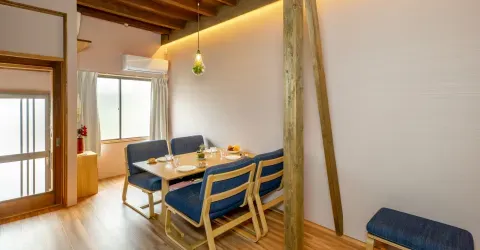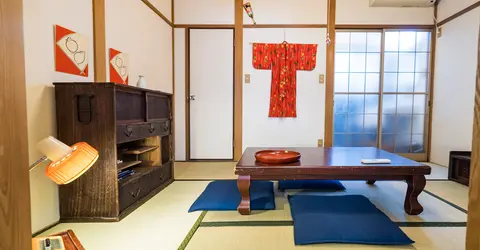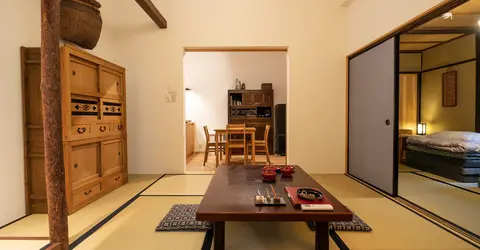Gekkeikan Sake Museum
Gekkeikan Sake Museum, Fushimi, Kyoto: read a guide to the historic sake brewing district of Fushimi in south Kyoto.
Fushimi - Kyoto's Old Sake Quarter - Gekkeikan Sake Museum 月桂冠大倉記念館
Johannes Schonherr

Gekkeikan Sake Brewery, Fushimi, Kyoto
In Japanese, sake, and its much more commonly used honorific form o-sake means simply "alcoholic drink". Thus, you have the sakaya (liquor store) and the izakaya, a traditional bar that also serves food.
In English and other European languages however, the word sake denotes a very specific mellow rice brew which is known in Japanese as nihonshu.
You can't walk into a Japanese liquor store and ask for sake. That would be the equivalent of walking into an American booze shop and asking for "some alcohol". You got to ask for a bottle of nihonshu and the staff will be happy to recommend their best.
That said, as this is a text in English for English-language readers, I will use the word sake in the Western way - meaning that one brew beloved by locals and visitors alike.
Japan is a country with a grand old drinking tradition and sake has been the national drink since times immemorial. The Shinto gods imbibe it in the ancient legends, Japanese history has been drenched in sake, Japanese culture is soaked in the drink.
Kyoto Fushimi is one of the greatest old sake brewing areas Japan has to offer, a place where sake has not only been made and served for the past 400 years but were it's history is visible and palpable at every corner.
Now, Fushimi Ward is a large and mostly industrial or residential area in southern Kyoto and the sake district is only a tiny portion of it. But if you take the Kintetsu Line to Momoyama-goryo-mae from Kyoto Station, it will get you right where you want to go. From the station (only one exit), walk to the right until you hit a shopping arcade, turn left and soon you will walk historic streets lined with vintage white-walled sake warehouses, old and new sake factories and a plethora of sake restaurants.
 Matsumoto Sake Brewery, Fushimi, Kyoto
Matsumoto Sake Brewery, Fushimi, Kyoto

Entrance to the Gekkeikan Sake Brewery showing the traditional sakabayashi - a ball of cedar twigs associated with sake producers nationwide, Fushimi, Kyoto
Uji River Canal
A good start of the day would be to go down to the Uji River Canal in front of Chokenji Temple. From here you can get on the Jukkokubune tour boat taking you along the narrow, willow-tree-lined canal and along the back of a good number of old sake breweries.
It was this canal that got the whole area started. Toyotomi Hideyoshi ordered the construction of the Uji River Canal in 1594, connecting the Hori River with the Uji River to speed up the transportation of construction materials for his new Fushimi Castle in the nearby Momoyama hills.
The castle itself turned out to be a luckless project. It was destroyed by an earthquake two years after it was completed, was then rebuilt, fell in a war related to the Tokugawa clan's rise to power after an eleven-day-siege in 1600 and was dismantled under new regulations on castles drawn up by the Tokugawa government in 1623. The Fushimi Castle you can see today was built in 1964 as a "Castle Entertainment Park" and this too was a luckless affair: the castle was abandoned in 2003.
 The long, traditional front of the Gekkeikan Sake Brewery, Fushimi, Kyoto
The long, traditional front of the Gekkeikan Sake Brewery, Fushimi, Kyoto
In contrast, the canal area thrived. The Uji River, and by extension, the Yodo River connected Kyoto with Osaka and merchants swarmed the area, creating one new business after another.
Clever folks soon figured out that this place had all the markings of a special kind of boom town: very tasty, soft water from the many branches of the Gokonomiya well (which translates to "Fragrant Water"), plenty of rice paddies over in what is today Shiga Prefecture, a thirsty population and easy transport routes. Thus, sake town was born. In 1657, a new licensing system for sake brewers was introduced. 83 Fushimi brewers were up to the new, tough standards. Today, Fushimi is home to about 37 sake makers.
One of the brewers has grown to be one of Japan's biggest sake producers Gekkeikan. The old Gekkeikan factory is only a few steps from the tour boat harbor and it houses today the Gekkeikan Okura Museum, a museum dedicated not only to company history but also displaying in detail the intricate process of making the brew.
The explanations are only in Japanese but there is enough visual material to understand the many steps necessary in making the liquor. If you got thirsty seeing all those sake-related tools and pictures, there is a sake-tasting table offering a great variety of free drinks. But don't get too drunk yet, there is much more to see in Fushimi.
The backstreets of Fushimi haven't changed their appearance for the last century or longer. Aside from the occasional shiny silos of new sake factories you will see an almost perfectly preserved piece of old Japan with largely wooden buildings and fortress-like storage houses, in which the sake barrels could survive earthquakes, wars and fires. It's quiet around here. Only a few tourists take time off from their busy tours of the temples and shrines of downtown Kyoto to come out here.


 Sake Brewery in Fushimi, Kyoto
Sake Brewery in Fushimi, Kyoto
Torisei Restaurant Kyoto
The Torisei Restaurant however is a busy spot and it is best to come rather late for lunch or early for dinner - otherwise you will have to wait in line with quite a lot of locals. They know where to get good food and the Torisei is famous for its yakitori chicken dishes. By all means, try the excellent chicken usuzukuri (slices of raw meat, only slightly roasted on the edges). Of course, this being Fushimi, the Torisei also brews their own sake.
If you happen to visit during the high season of sake making, running roughly from November through March, try the freshly made, un-pasteurized tarekuchi sake. It comes straight from the barrel and has to be consumed within days after production. It's delicious and the waiters pour generous amounts: under your sake cup is a deep saucer and the waiter will not stop pouring when the cup is filled up.
He continues until the saucer is also full. One cup goes down easily one after the other. Don't miss your last train back and make sure to buy a bottle or two to take home.
 Sake Brewery area in Fushimi, Kyoto
Sake Brewery area in Fushimi, Kyoto
Gekkeikan Sake Museum Access
Jukkokubune Boat Tour
Hours: 10 am- 4.30 pm (10 am- 8.50 pm) from early June through late August), each tour takes about 45 minutes and costs 1000 yen including a bottle of sake, 500 yen for children.
Tel: 075 623 1030
Gekkeikan Okura Museum
Hours: 9 am- 4.30 pm
Tel: 075 623 2056
Torisei
Hours: 11.30 am -11.30 pm (last order 10.30 pm), closed Monday
Tel: 075 622 5533
 Torisei, Fushimi, Kyoto
Torisei, Fushimi, Kyoto Torisei, Fushimi, Kyoto
Torisei, Fushimi, Kyoto
The views expressed in this article are solely those of the author.
A version of this article first appeared in Kansai Time Out magazine.
Related Japan Food & Drink Articles
Izakaya - the Japanese pub
Drinking in Japan
Kirin Beer
Restaurants Bars & Clubs in Kyoto





























